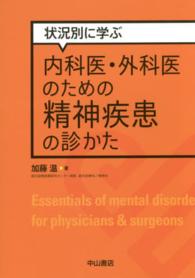Full Description
A comprehensive guide to help practitioners diagnose the cause of pain based on symptoms presented, and facilitate its management with appropriate treatment. Beginning with an introduction to clinical examination and radiology, the following sections each examine pain in a different part of the body and possible causes and treatment. The final sections discuss alternative pain management with physiotherapy, psychotherapy and allied therapy.
Contents
SECTION A-CLINICAL EXAMINATION.1. General Clinical and Patient Examination Form2. Informed Consent3. Clinical Examination and Evaluation of Cervical Spine4. Clinical Examination and Evaluation of Lumbar SpineSECTION B-RADIOLOGY.5. Interpretation of X-ray Spine6. Interpretation of CT Scan for Interventional Pain Treatment Procedures7. Interpretation of MRI for Pain Practice8. Role of Electrodiagnosis in the Management of Neck and Back Pain9. Interpretation of Bone Mineral Density and Its TreatmentSECTION C-LOW BACK PAIN.10. Focal Back Pain and Its Management11. Lumbosacral Radiculopathy Pain and Its Management12. Lumbar Facet Pain Syndrome and Its Management13. Lumbar Spinal/Canal Stenosis and Its Pain Management14. Lumbar Diskogenic Back Pain and Its Management15. Sacroiliac Joint Pain Syndrome and Its Management16. Coccygodynia: Causes and Pain Management17. Piriformis and Iliopsoas Pain Syndromes and Its Pain ManagementSECTION D-CERVICAL NECK PAIN.18. Headache: Causes and Treatment Modalities19. Trigeminal Neuralgia: Causes and Treatment20. Cervical Radiculopathy Pain and Its Management21. Cervical Facet Joint Pain and Its Management22. Cervical Diskogenic Pain and Its ManagementSECTION E-CANCER PAIN23. Head and Neck Cancer Pain Management24. Carcinoma Breast: Pain and Its Management25. Carcinoma Lung: Pain and Its Management26. Upper Abdominal Malignancy Pain and Its Management27. Malignant Pelvic Pain and Its Management28. Metastatic Bone Pain ManagementSECTION F-UROGENITAL AND PELVIC PAIN29. Nonmalignant Urogenital Pain Management30. Nonmalignant Pelvic Pain ManagementSECTION G-NEUROPATHIC PAIN.31. Diabetic Neuropathy: Pain and Its Management32. Neuropathic Pain: Pathophysiology and Pain ManagementSECTION H-ISCHEMIC PAIN.33. Peripheral Vascular Disease: Causes and Pain ManagementSECTION I-MYOFASCIAL PAIN.34. Back and Related Muscle Spasm: Causes and Pain Management35. Fibromyalgia: Causes and Pain ManagementSECTION J-SCAR PAIN.36. Post Herniorrhaphy Pain and Its Management37. Post CABG Scar Pain and Its SECTION K-CHALLENGING PAIN.38. Complex Regional Pain Syndrome (CRPS): Causes and Pain Management39. Phantom Limb Pain: Causes and Pain Management40. Post Herpetic Neuralgia: Causes and Pain Management41. Post Laminectomy Pain and Its Management42. Restless Leg Syndrome: Causes and Pain ManagementSECTION L-PHYSIOTHERAPY.43. Role of Physiotherapy in Treatment of Spinal Pain during Acute Inflammatory Phase44. Role of Physiotherapy in Management of Spinal Pain during Subacute Reparative Phase45. Role of Physiotherapist in Management of Chronic PainSECTION M-PSYCHOTHERAPY.46. Psychiatric Medications in Chronic Pain Management47. Pain Psychology and Its Treatment OptionsSECTION N-ALLIED THERAPY.48. Role of Radiation Therapy in Chronic Pain Management49. Role of Chemotherapy in Chronic Pain Management50. Role of Oncosurgery in Chronic Pain Management51. Role of Yoga and Relaxation Exercises in Chronic Pain ManagementSECTION O-MISCELLANEOUS52. Management of Chronic Ophthalmic Pain53. Interpretation of Blood Levels of Drugs Used in Chronic Pain Management54. How to Set up Pain Management Clinic?Index








